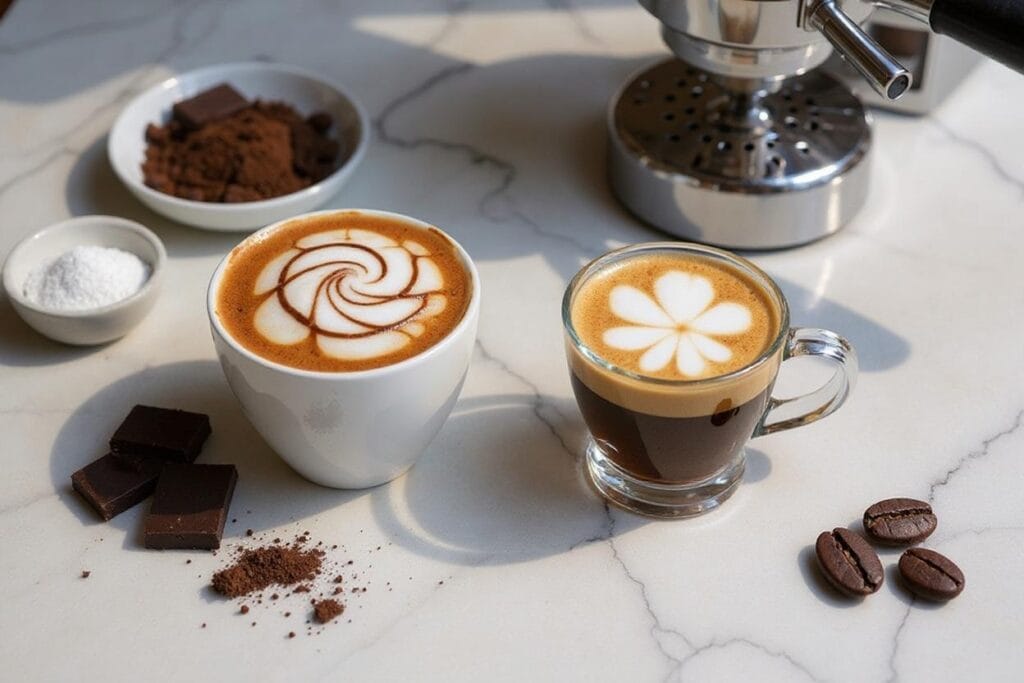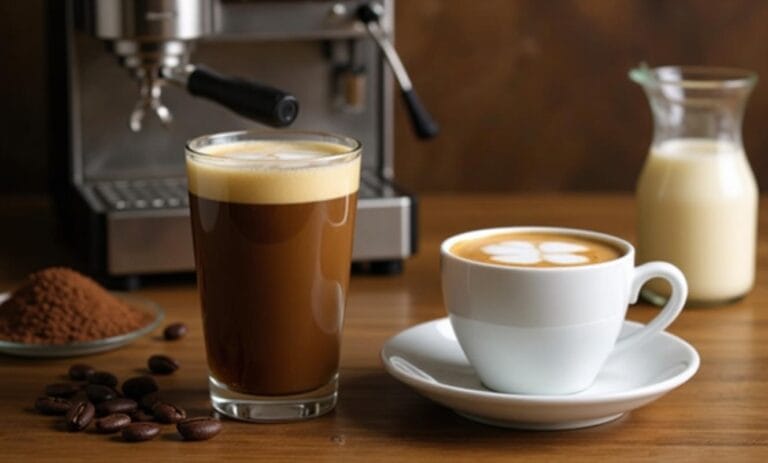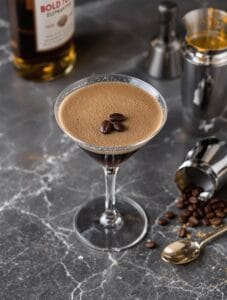Mocha and macchiato clash in three bold ways. Initially, ingredients: mocha mixes espresso, steamed milk, and chocolate (like a dessert in a cup), while macchiato layers espresso with just a splash of milk foam (tiny but mighty). Subsequently, taste: mocha screams cocoa sweetness and creaminess, while macchiato roasts your taste buds with strong, bitter coffee vibes. Finally, calories: mocha’s sugar-heavy setup can hit 350 calories (yikes!), but macchiato sips light at 17-100. Want the full brew-down? Let’s grind deeper.
Ingredient Composition and Milk Content

Mocha and macchiato may both start with espresso, but in regard to milk, they’re like distant cousins at a family reunion — one brings a whole party, the other just a tiny hello! The coffee industry’s trend towards sustainable coffee has also led to innovative milk alternatives, catering to the growing demand for eco-friendly options.
A mocha rolls with 8-12 ounces of steamed milk**, frothy foam, and chocolate sauce, creating a creamy, chocolate-coffee mashup. Baristas mix milk types like whole or skim with cocoa, blending it all into a smooth, rich treat**.
The macchiato? It’s espresso’s bold sidekick, topped with a spoonful of milk foam** — no chocolate, steamed milk, or fancy extras. Its milk preparation is quick: foam gets plopped on espresso like a tiny hat, marking it without muting coffee’s kick**.
Mocha’s milk-heavy build even leaves room for whipped cream (party animal!), while macchiato keeps it lean. This heavy milk and chocolate combo cranks mochas to 160 calories per serving, while macchiatos stay feather-light at just 14. Milk’s the star here — less is *way* more for one, and more is… more for the other!
Flavor Profile and Sweetness Levels

While ingredients like milk and chocolate shape these drinks, they also set them worlds apart in taste and sweetness.
A mocha is a chocolate-forward dance party—rich, creamy, and sweet, like sipping melted dessert, with cocoa mellowing espresso’s bite. This indulgence comes at a caloric cost, as chocolate and steamed milk significantly boost its calorie count compared to the minimalist macchiato. The historical significance of mocha is rooted in the coffee trade of Al Mokha, Yemen, which played a crucial role in shaping the modern mocha flavor profile.
Macchiato, however, is espresso in a tuxedo: bold, robust, and slightly bitter, wearing just a splash of milk foam for elegance.
Sweetness here? Subtle, barely a whisper.
Taste comparisons reveal mocha’s sugary punch (thanks to chocolate syrup, whipped cream) versus macchiato’s coffee purity.
The choice between mocha and macchiato can also depend on the coffee culture and the type of experience one is looking for, whether it’s a casual or formal setting.
Preference factors hinge on cravings: sugar rush or espresso kick.
Your pick? Craving a sugar rush or an espresso kick? The choice rides on what your tastebuds demand.
Want nutty caramel twists? Mocha’s game.
Crave unapologetic coffee strength? Macchiato’s your badge of honor.
One hugs your sweet tooth, the other shakes hands with your inner coffee purist—no sugarcoat, just soul.
Caloric Content and Nutritional Impact
With regard to coffee drinks, their calorie counts couldn’t be more different—picture a mocha flexing with chocolate syrup, stacks of milk, and whipped cream (hello, 160-350 calories!), while a macchiato sips espresso with just a splash of foam, clocking in at 17-100 calories.
The caloric differences boil down to ingredients—mocha’s chocolate, sugar-loaded milk, and whipped toppings stack fat (17 grams!) and carbs, making it a dessert-in-disguise.
Meanwhile, macchiato’s minimalist espresso-and-foam combo keeps fat low (3.5 grams) and sugar under 7 grams.
Nutritional effects? Mocha’s sugar rush and creamy richness fuel indulgence, but daily sipping could derail diets.
Macchiato offers freedom from guilt, serving bold coffee flavor with a lighter footprint, perfect for body-conscious rebels.
Choose mocha for a treat, macchiato for a caffeine kick without the baggage.
Frequently Asked Questions
Can Macchiatos and Mochas Be Prepared as Iced Beverages?
Over 60% of coffee drinkers prefer iced beverages during summer. Iced preparation is feasible for both, with macchiatos emphasizing bold espresso and flavor infusion via syrups, while mochas blend chocolate richness into chilled coffee bases.
Do Macchiatos or Mochas Pair Better With Specific Desserts?
Dessert pairings for macchiatos or mochas align with flavor profiles: mochas complement chocolate-based or spiced desserts via sweetness, while macchiatos balance nutty or creamy textures with bold espresso, enabling tailored selections to individual taste freedoms.
How Do Barista Techniques Differ When Making Each Drink?
Baristas adjust techniques with frothed milk and espresso shots—mochas demand layered chocolate integration and steamed milk volume, while macchiatos prioritize minimal, dense foam placement to preserve espresso intensity, requiring distinct pouring precision and textural control.
Are Macchiatos or Mochas More Popular in European Cafes?
Macchiato popularity remains higher in European cafes due to entrenched espresso traditions, particularly in Italy and Spain. Mocha trends show niche appeal among sweet-tooth consumers but lag in mainstream adoption compared to classic espresso-based drinks.
Can Either Drink Be Made Without an Espresso Machine at Home?
Both drinks can be made without an espresso machine. A French Press yields strong coffee, while Instant Coffee mimics espresso concentration; manual milk frothing suffices. Chocolate in mocha and minimal foam in macchiato allow adaptable home preparation.
References
- https://www.everydaydose.com/blogs/all/macchiato-vs-mocha
- https://foragersofhappiness.com/mocha-vs-macchiato-all-the-key-differences-explained/
- https://kahwati.co.uk/difference-between-mocha-and-macchiato/
- https://lifeboostcoffee.com/blogs/news/caramel-macchiato-vs-white-chocolate-mocha
- https://coffeeme.in/espresso-culture/mocha-vs-macchiato-whats-the-difference/
- https://lifeboostcoffee.com/blogs/news/macchiato-vs-mocha
- https://www.coffee-collective.co.uk/blogs/coffee-news/do-you-know-your-mocha-from-your-macchiato
- https://mylattecoffee.com/macchiato-vs-mocha/
- https://www.ckitchen.com/blog/2022/6/fresh-n-hot-learn-the-differences.html





